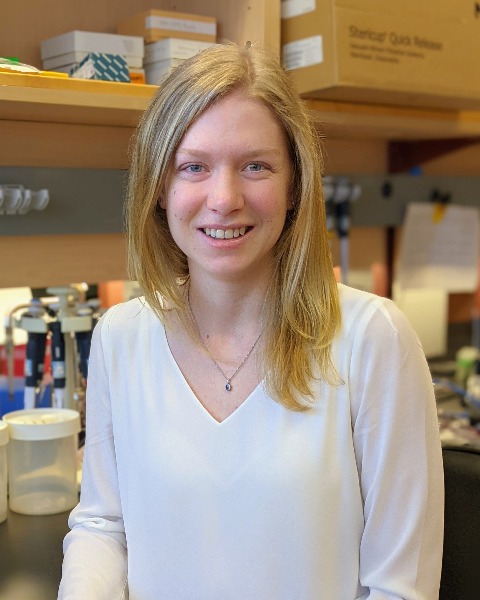Cellular and T cell engager Immunotherapy
Poster Session 1
P-022: DEVELOPMENT OF TROGOCYTOSIS RESISTANT CAR-NK FOR MULTIPLE MYELOMA
Wednesday, September 27, 2023
1:30 PM - 2:30 PM EEST

Marisa K. Kilgour, PhD (she/her/hers)
Postdoctoral Fellow
Ottawa Hospital Research Institute
Vanier, Ontario, Canada
Introduction: Multiple Myeloma (MM) remains an incurable disease, with a median survival of 8.6 months in patients refractory to conventional therapies. There is a great interest in translating chimeric antigen receptor (CAR) therapies to MM, where new therapeutic options are direly needed. Both CAR-T cells, now widely used, and CAR-NK cells, still at an experimental stage, must face evasion mechanisms that make tumor cells resistant to CAR-mediated killing. One of these mechanisms, trogocytosis, has emerged as a major hurdle in the effectiveness of CAR therapy, but strategies to overcome it are still lacking. During trogocytosis, NK cells capture and express the membrane and associated proteins of MM cells on their cell surface leading to negative consequences such as fratricide and antigen loss on the target cells.
Methods: We set up an in vitro model to study the extent to which CAR-NK cells perform trogocytosis with MM cells and assessed if the structure of the CAR would change the amount of trogocytosis that occurred. We took advantage of NK92 cells, a human NK cell line widely used in preclinical studies, that we transduced with a BCMA targeted CAR construct. We labelled MM cells (with variable expression of BCMA) with Cell Trace Violet (CTV) and co incubated the labelled cells with CAR NK cells. Following 1 hr co incubation, we assessed transfer of cell dye as well as other specific MM markers, including BCMA, by flow cytometry. We repeated this assay with CAR structures varying in the affinity of the antigen binding domain for BCMA and the hinge length.
Results: Consistent with our hypothesis, CTV dye was transferred to CAR NK cells incubated with MM cell lines, along with BCMA. In contrast, after co incubation with BCMA deficient cells, CAR NK cells failed to stain for BCMA and had lower CTV. Importantly, pre incubating CAR NK cells with the trogocytosis inhibitor latrunculin abolished BCMA acquisition from MM cells. Surprisingly, changing the affinity of the binding domain for BCMA did not alter trogocytosis, however, we found that hinge length had a positive correlation with trogocytosis. In the future, we will apply these methods to primary NK and MM cells as well as in vivo to assess the efficacy of our CAR constructs.
Conclusions: Taken together, these experiments show that BCMA targeted CAR expression in NK cells greatly enhances trogocytosis of MM antigens, including BCMA. In addition, we demonstrated that the structure of the CAR influences the amount of trogocytosis that occurs. Further studies are needed to determine how we can generate trogocytosis-resistant CAR-NK to improve therapy for MM.
Methods: We set up an in vitro model to study the extent to which CAR-NK cells perform trogocytosis with MM cells and assessed if the structure of the CAR would change the amount of trogocytosis that occurred. We took advantage of NK92 cells, a human NK cell line widely used in preclinical studies, that we transduced with a BCMA targeted CAR construct. We labelled MM cells (with variable expression of BCMA) with Cell Trace Violet (CTV) and co incubated the labelled cells with CAR NK cells. Following 1 hr co incubation, we assessed transfer of cell dye as well as other specific MM markers, including BCMA, by flow cytometry. We repeated this assay with CAR structures varying in the affinity of the antigen binding domain for BCMA and the hinge length.
Results: Consistent with our hypothesis, CTV dye was transferred to CAR NK cells incubated with MM cell lines, along with BCMA. In contrast, after co incubation with BCMA deficient cells, CAR NK cells failed to stain for BCMA and had lower CTV. Importantly, pre incubating CAR NK cells with the trogocytosis inhibitor latrunculin abolished BCMA acquisition from MM cells. Surprisingly, changing the affinity of the binding domain for BCMA did not alter trogocytosis, however, we found that hinge length had a positive correlation with trogocytosis. In the future, we will apply these methods to primary NK and MM cells as well as in vivo to assess the efficacy of our CAR constructs.
Conclusions: Taken together, these experiments show that BCMA targeted CAR expression in NK cells greatly enhances trogocytosis of MM antigens, including BCMA. In addition, we demonstrated that the structure of the CAR influences the amount of trogocytosis that occurs. Further studies are needed to determine how we can generate trogocytosis-resistant CAR-NK to improve therapy for MM.
